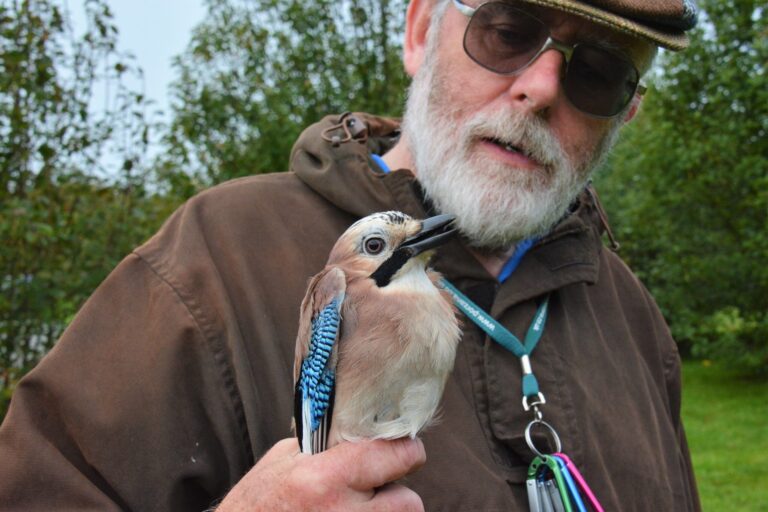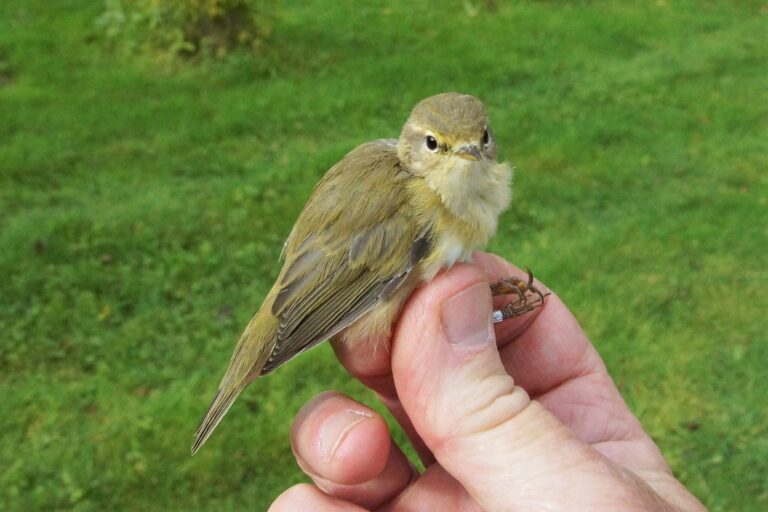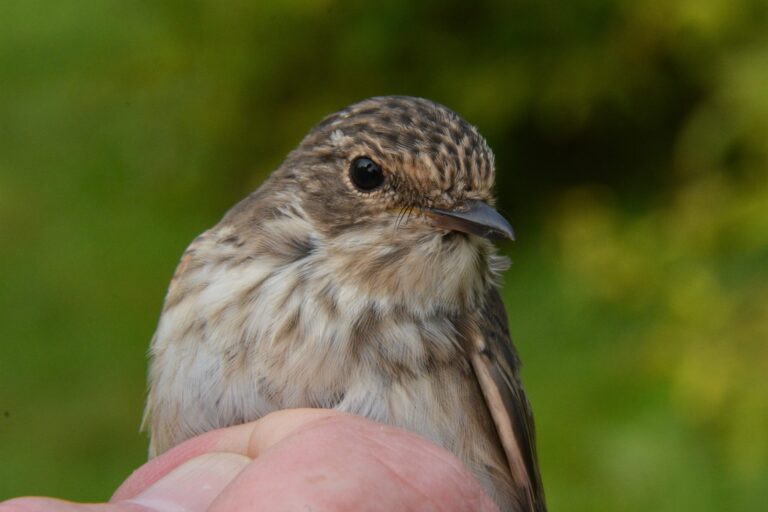News from the BTO this month came in a return about a Barn Owl found dead in a water-butt (if outside they should always be covered). The finder thought it must be a young local owl but the ring number on its leg told a more interesting story. GV20107 had in-fact been ringed near Galashiels in the Scottish Borders as a breeding adult male in May 2018. So, on finding he was perhaps 4 yrs. old.
Ringing at Howick during September has been a continuing battle against the weather and my trainees have had to put up with changes of day to dodge the rain and wind. However, starting on the 6th we had a good catch of 69 (25 retraps and 44 new). Included in the re-traps was female Chaffinch from 2015 while new birds included lots of Chiffchaffs and Blackcaps; all warblers feeding up prior to migration south. Several of the Blackcaps were carrying a lot of fat (scored like a little pack of butter in their trachea at 4 and 5 ‘fat’). Alison and I were lucky enough to get away to Italy, for a week on a long-awaited holiday, with Nature Trek and so a fellow Trainer ran a session for three of my trainees on the 14th. This captured 17 retraps and 28 new birds. The retraps included a Blackbird from 2016 while notable in the new birds were more Blackcaps and the odd Chiffchaff. Local birds included some Long-Tailed Tits, that seem to move into the area this time of year.
Ringing again on the 20th (this time on my own because we thought that meeting outside had been banned) I netted 10 retraps and 27 new birds. The retraps included a Blue Tit from 2014. Notable in the new birds were 8 Long Tailed Tits all in the same net at the same time. These were rapidly followed by a juvenile Great Spotted Woodpecker (noisy), a rather angry and violent Jay (also noisy) and a much more well-behaved young Spotted Flycatcher. Luckily, Alison arrived in time to assist me with the Jay (its exceedingly difficult to take notes when a strong adult female Jay is trying to injure you!). See pictures. There were also a few Chiffchaffs but no Blackcaps to be seen. Incidentally, the Spotted Flycatcher was on its migration which takes it all the way across the Sahara and the Equator to Cameroon, East Africa, and down into southern Africa.

Back with a small team on the 28th we had a fascinating morning catching 66 birds (23 retraps and 66 new). The retraps were mostly local tits plus a lovely young Treecreeper that we ringed back on the 7th August. These are difficult birds to ‘age’, so it was interesting to see how its plumage had changed over that period. However, the first exciting bird was a Yellow-browed Warbler (quickly followed by another) a rare but regular migrant that is pioneering a new migration route. It should be travelling from the Ural Mountains and Siberia south into Indochina, but small numbers seem to be migrating west instead; into Europe and even Africa (see photo.). Then things became noisy with the coarse calls of Mistle Thrushes apparently migrating in off the sea (although of course they are both a resident and an in-coming migrant this time of year) we captured nine in all plus a Song Thrush and a single Redwing, the first seen this autumn; all had few fat reserves suggesting they had just travelled a great distance. The Redwing is of course a much smaller thrush and a definite migrant. See photo of a Mistle Thrush together with the Redwing.

After a long morning with more local birds processed, I took the final bird out of the nets and on putting it in its bag registered that it was probably a late willow warbler. A short time later my most experienced trainee decided it was more likely a chiffchaff. This set off a lot of checking through books and taking additional biometrics. The eventual conclusion after 30 mins (and it would have been wrong to keep it any longer) was that it was an Iberian Chiffchaff (see photo.) A closely related species at one time considered merely a sub-species of the chiffchaff. Its wings were too short to be a willow warbler, its legs were the wrong colour to be a chiffchaff and to complicate matters it was an adult bird in Main Moult. What it was doing at Howick this time of year is an interesting question – an Iberian Chiffchaff would normally have been expected to come in as a spring migrant having overshot its more normal geography on returning from Africa. However, a better explanation proffered by my scribe (a retired ringer and wildlife guide) was that it probably had arrived in the spring and lived quite satisfactorily alongside the other migrants until being captured today. Showing a picture to several other ‘experts’ produced some interesting responses: One local amateur insisted it was a Chiffchaff, another professional thinks it’s an aberrant Willow Warbler or a hybrid bird. This pushed me back to checking one of my books again where it says “Iberian Chiffchaff – resembling hybrid between P. collybita and P. trochilus (that is between a chiffchaff and a willow warbler)!


We are currently limited to 6 people at a time at the Howick Ringing Station, but this has not proved a problem to date. Maybe we will see some Brambling next week?
Best Regards,
Phil Hanmer
S Ringer/Trainer; Natural History Society of Northumbria Ringing Group (Hancock Museum)
E-mail: tytoalbas@btinternet.com